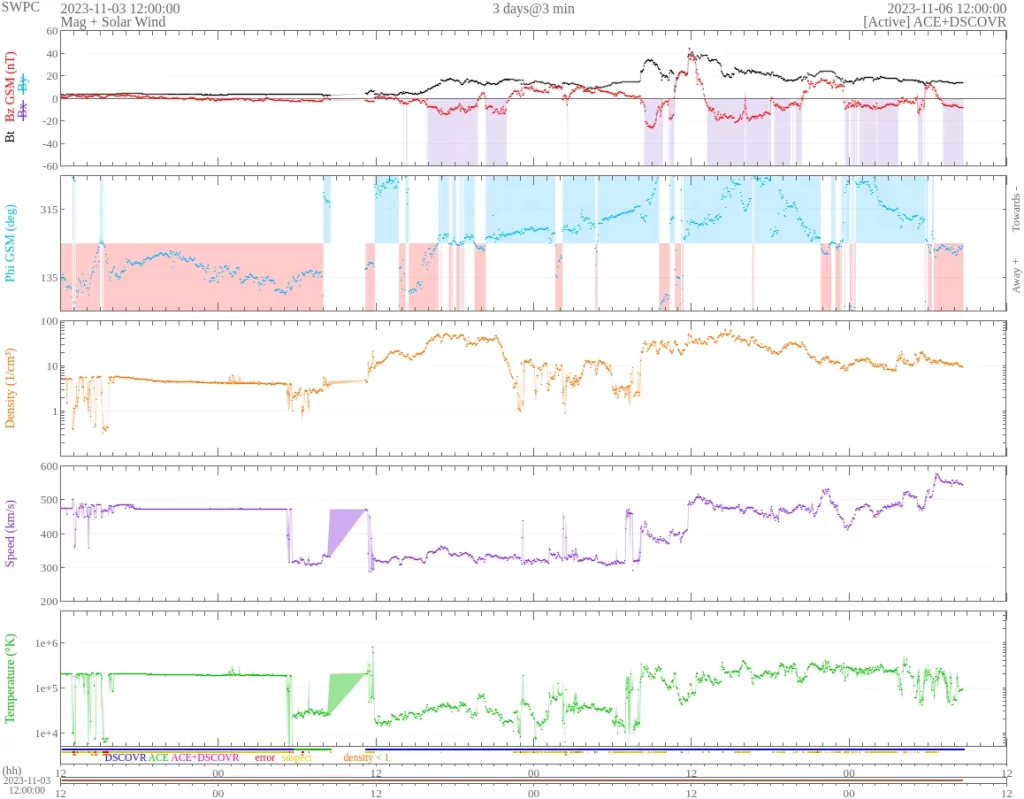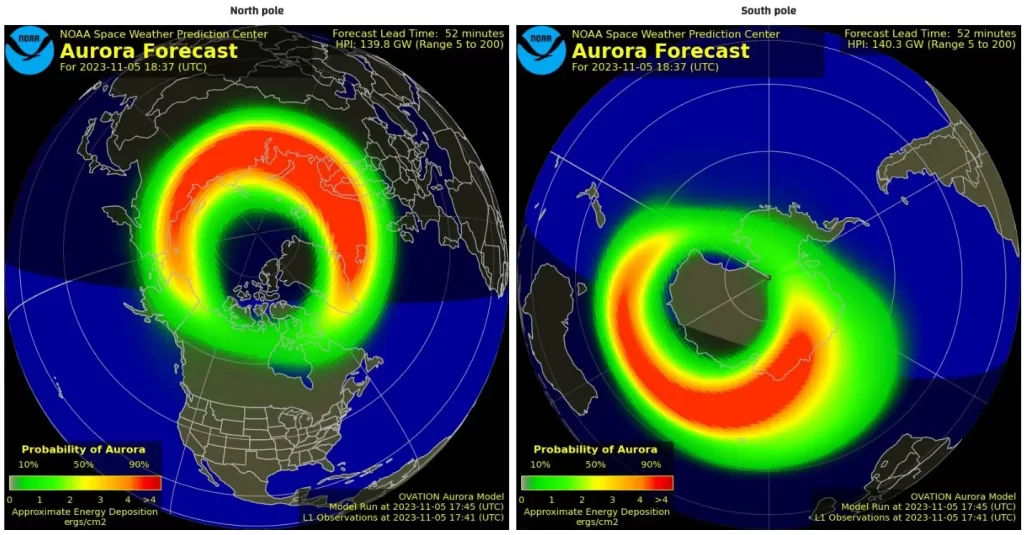Geomagnetic storm reaches G3 – Strong level after dual CME impact
A G3 – Strong geomagnetic storming was observed on Sunday, November 5, 2023, as a result of the impact of two successive coronal mass ejections (CMEs) from the Sun. The storm produced auroras extending into the lower latitudes such as Colorado and Texas in the United States and Greece in Europe, which is unusual for such regions. Many people across both hemispheres have also recorded and captured rare red aurora.
A G3 – Strong geomagnetic storm was observed on Sunday, November 5, due to the impact of two CMEs that erupted on November 2 and 3.
The initial signs of solar wind enhancement were detected at 08:10 UTC on November 5, where instruments recorded a significant increase in the solar wind’s total field strength to 34 nanoteslas (nT). The southward deflection of the magnetic field, known as the Bz component, reached a notable low of -27 nT. Despite this initial shock, solar wind velocities were recorded at a peak of 434 km/s, which is relatively moderate in terms of solar wind speed enhancements.
The subsequent shock, more powerful than the first, was logged beginning at 11:46 UTC on the same day. A sharp rise in the total field strength to 45 nT was observed, followed by a gradual decrease. Notably, the Bz component rotated southward in the hours following this second impact, registering strongly negative values between -15 and -20 nT from 13:50 to 18:00 UTC. The solar wind speed peaked at 517 km/s at 12:33 UTC, before tapering off to approximately 460 – 480 km/s.




A continuation of the enhanced solar wind conditions is forecast until approximately midday on November 6, owing to the lingering effects of the CMEs. However, a subsequent increase in solar wind strength could occur late on November 7 through 8 due to the anticipated impact of a co-rotating interaction region (CIR) and a high-speed stream (HSS) from a negative polarity coronal hole.
For November 6, the prediction is for G1 – G2 (Minor – Moderate) geomagnetic storm levels as a response to the sustained CME activity and potential for substorms. On November 7 and 8, periods of active geomagnetic conditions are anticipated due to the influence of the CIR and the negative polarity CH HSS.
Solar activity was at moderate levels over the past 36 hours, with two impulsive M1 flares detected at 11:43 and 14:32 UTC.
Over the next 3 days, solar activity is expected to be low, with a chance for isolated R1 – R2 (Minor – Moderate) events (25%).
The greater than 2 MeV electron flux was at normal to moderate levels over the past 36 hours and the greater than 10 MeV proton flux was steady at background levels. Similar levels are expected over the next 3 days.
6 minutes of #AuroraBorealis #timelapse, sped up 180X. I normally time lapse at 300X, but this was too active for that pace. Taken from near Carseland, AB at 9:36 pm MST. @TweetAurora @spaceyliz @ratzlaff @TamithaSkov @MyRadarWX pic.twitter.com/jzGFovJsuH
— RASC Calgary Centre (@CalgaryRASC) November 6, 2023
🌌 Weergaloze avond met noorderlicht tot boven ons hoofd in Brabant! Het paars was visueel prima zichtbaar. Zelfs tot in de Alpen, Kroatië en Spanje zijn deze kleuren gespot… 👇 #Auroraborealis #northernlights
— Wouter van Bernebeek (@StormchaserNL) November 6, 2023
@StormHour @TamithaSkov @omroepbrabant pic.twitter.com/8368OE9j9x
Caught in Ireland tonight just outside Dublin 🙌💚 pic.twitter.com/xsc8Eo13ln
— Dublincityphotography (@keitho1888) November 6, 2023
The promised timelapse video from my kitchen window photo bombed by someone who shall remain nameless looking for a snack in the fridge.
— Edwin Mabonga 🧢 (@Edwinmab1) November 6, 2023
Armature!!! pic.twitter.com/LsIl517dCm
References:
1 Forecast Discussion – Issued: 2023 Nov 06 0030 UTC – Prepared by the U.S. Dept. of Commerce, NOAA, Space Weather Prediction Center
Featured image: Red aurora over Greece on November 5, 2023. Credit: xanthinea.gr


Commenting rules and guidelines
We value the thoughts and opinions of our readers and welcome healthy discussions on our website. In order to maintain a respectful and positive community, we ask that all commenters follow these rules.